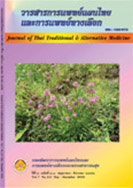Toxicity Study of Lupinifolin from Stem of Derris reticulata Craib
Main Article Content
Abstract
Lupinifolin is a flavonone compound expressing high efficacy against Herpes simplex virus 1 (HSV-1). The objective of this study was to investigate the toxicity of lupinifolin from the stem of Derris reticulata Craib.
Oral administration of lupinifolin in mice at the dose of 5 mg/kg, which was equivalent to an 8,300-fold therapeutic dose, showed no acute toxicity. A subacute toxicity study was performed on six groups of Wistar rats for 28 days. Groups 1 and 2 were control groups given distilled water and 1 percent tragacanth, respectively. Groups 3 to 6 were administered lupinifolin orally at doses of 0.6, 6.0, 3.0 and 60 mg/kg/day, which were equivalent to 1, 10, 50 and 100 times the therapeutic dose, respectively. The results revealed that lupinifolin did not affect body weight, food consumption or the animals’ health. Female rats receiving lupinifolin at the dose of 60 mg/kg/day had a significant increase in WBC and a significant decrease in neutrophils when compared with the water control group, but these changes were within normal ranges. Male rats receiving lupinifolin at doses of 30 and 60 mg/kg/day and female rats receiving lupinifolin at 60 mg/kg/day had a significantly higher sodium level than the water control groups; nevertheless, the increase was within the normal range. The potassium level in female rats receiving lupinifolin at doses of 30 and 60 mg/kg/day was significantly lower
than that of the water control group. Histopathological results of some visceral organs in the lupinifolintreated groups showed no dose-dependent alterations; therefore, lupinifolin from D. reticulata should be considered
safe for the treatment of HSV1-infected wounds.
Article Details
References
2. Lin YL, Chen YL, Kuo YH. Three new flavonoids, 3û-methoxylupinifolin,laxifolin, and isolaxifolin from the roots of Derris laxiflora Benth. Chem Pharm Bull 1991;39:3132-5.
3. Shirataki Y, Matsuoka S, Komatsu M, Ohyama M, Tanaka T, Iinuma M. Four isoflavanones from roots of Sophora tetraptera. Phytochemistry 1999;50:695-701.
4. Mahidol C, Prawat H, Ruchirawat S, Likhitwitayawuid K, Lin LZ, Cordell GA. Prenylated flavanones from Derris reticulata. Phytochemistry 1997;45:825-9.
5. Soonthornchareonnon N, Ubonopas L, Kaewsuwan S, Wuthi-Udomlert M. Lupinifolin, a bioactive flavonone from Myriopteron extensum (Wight) K. Schum. Stem. Thai Journal of Phytopharmacy 2004;11:19-28.
6. วราภรณ์ จรรยาประเสริฐ. การพัฒนาผลิตภัณฑ์ยาต้านเริมจากสารลูปินิโฟลิน. ใน: สุนันทา สมพงษ์, นิตยา พุทธโกษา, สุภาพร โชคเฉลิมวงศ์, พรวันอาสา บำรุงไทย, อุมารินทร์ เฉิดโฉม (บรรณาธิการ). การเผยแพร่ผลงานวิจัยด้านการพัฒนาสมุนไพรเพื่ออุตสาหกรรม;๒๘-๒๙ กันยายน ๒๕๔๙; ณ โรงแรมมิราเคิล แกรนด์ คอนเวนชั่น กรุงเทพมหานคร: ภารกิจโครงการและประสานงานวิจัย สำนักงานคณะกรรมการวิจัยแห่งชาติ; ๒๕๔๑ หน้า ๔๓๒-๔๓๐.
7. เยาวลักษณ์ พิมายนอก , อังสนา โยธินารักษ์, พศวัต จรเกตุ. ค่าอ้างอิงทางโลหิตวิทยาและเคมีคลินิกในเลือดหนูแรทสายพันธุ์วิสตาร์ วารสารกรมวิทยาศาสตร์การแพทย์ ๒๕๔๖;๔๕(๑):๒๗-๓๖.
8. Gad SC. The rat. In: Gad SC, Chengellis CP, editors. Animal models in toxicology. New York: Marcel Dekker, 1992. p.81.
9. Stockham SL, Scott MA. Fundamentals of veterinary clinical pathology. Ames: Iowa State Press; 2002.


